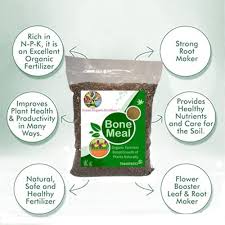Unlocking the Power of Bone Meal: A Natural Boost for Thriving Plants
Bone Meal for Plants is an essential organic fertilizer that enriches soil, promotes robust root development, and boosts flowering for a thriving garden . If you’re looking to elevate your gardening game, you might want to consider bone meal—an organic fertilizer that has been used for generations to enhance plant growth. Packed with essential nutrients, bone meal is particularly rich in phosphorus and calcium, making it an excellent choice for promoting healthy root development and vibrant blooms. This guide will walk you through everything you need to know about using bone meal effectively, from its benefits and application methods to tips for selecting the right product for your garden.

What is Bone Meal?
Bone meal is a fine powder made from crushed animal bones, typically those of cattle or fish. This organic fertilizer is an excellent source of essential nutrients, especially phosphorus, which is crucial for plant development. Phosphorus aids in root formation, flower and fruit production, and overall plant vigor. Additionally, bone meal contains calcium, which contributes to cell wall structure and is vital for the growth of strong, healthy plants.
Benefits of Bone Meal for Plants
1. Promotes Root Development
One of the primary benefits of bone meal is its ability to promote robust root systems. Healthy roots are essential for plants to absorb water and nutrients effectively. The phosphorus in bone meal helps establish strong roots, making plants more resilient to environmental stresses.
2. Enhances Flower and Fruit Production
Bone meal is particularly beneficial for flowering and fruiting plants. The nutrients it provides support the formation of flowers and fruits, leading to a more abundant harvest. Whether you’re growing tomatoes, roses, or fruit trees, incorporating bone meal into your gardening routine can lead to more prolific blooms and higher yields.

3. Improves Soil Quality
Using bone meal also enhances soil quality over time. As it breaks down, it releases nutrients into the soil, improving its overall fertility. This slow-release characteristic ensures that your plants receive a steady supply of nutrients, which is essential for long-term growth.
How to Use Bone Meal for Optimal Plant Growth
Application Techniques
- Soil Amendment: Incorporate bone meal directly into the soil when planting. This method ensures that the nutrients are readily available to the plant roots.
- Topdressing: Sprinkle bone meal around established plants as a topdressing. Gently work it into the soil surface to make it accessible to the roots.
Frequency of Application
For best results, apply bone meal at the beginning of the growing season, typically in early spring. Depending on the specific needs of your plants, you may want to reapply every 4-6 weeks throughout the growing season. Always follow the manufacturer’s instructions for application rates.
Best Plants for Bone Meal
Certain plants thrive particularly well with the addition of bone meal. Here are some examples:
- Vegetables: Tomatoes, peppers, and squash benefit from the phosphorus in bone meal, promoting healthy blooms and fruiting.
- Flowers: Bulb flowers such as tulips and daffodils, as well as perennials like peonies, can thrive with bone meal applications.
- Fruit Trees: Apple, peach, and cherry trees often yield better fruit with the added phosphorus and calcium from bone meal.
Choosing Quality Bone Meal for Your Plants
When selecting bone meal, consider the following factors:
- Organic Certification: Look for products that are certified organic to ensure you’re using a natural fertilizer free from synthetic additives.
- Source: Choose reputable brands that provide information about the sourcing of their bone meal. This transparency ensures you’re getting a high-quality product.
Popular Bone Meal Brands
Some well-known brands of bone meal include:
- Espoma Bone Meal: A trusted name in organic gardening, Espoma’s bone meal is made from natural sources and is great for all types of plants.
- Down to Earth Bone Meal: This brand offers a high phosphorus content and is also certified organic.
DIY Bone Meal Tips
If you’re interested in a more sustainable approach, you can create your own bone meal at home. Here’s how:
- Collect bones: Use leftover bones from cooking—beef, chicken, or fish bones work well.
- Clean and dry: Remove any remaining meat and fat, then dry the bones in the oven on low heat until completely dry.
- Grind: Use a blender or food processor to grind the bones into a fine powder.
Potential Drawbacks and Precautions
While bone meal is an excellent organic fertilizer, it’s essential to use it properly to avoid any drawbacks:
- Overuse: Excessive application can lead to phosphorus buildup in the soil, which may harm certain plants and disrupt soil health. Always follow recommended application rates.
- Pet and Wildlife Safety: Since bone meal is made from animal bones, it can attract pets and wildlife. Store it securely and apply it away from areas frequented by animals.
Natural Growth Booster for Thriving Gardens
Bone meal is a powerful, natural growth booster that can transform your garden into a thriving oasis. With its ability to promote healthy root systems, enhance flower and fruit production, and improve soil quality, it’s an essential tool for any gardener looking to achieve vibrant and productive plants.
By incorporating l into your gardening routine, you’re not only nurturing your plants but also contributing to a healthier environment. So why not give it a try? Your plants will thank you for it!
For more gardening tips and insights, explore our blog at Garden Info Site.
Frequently Asked Questions About Bone Meal for Plants
FAQ 1: What is bone meal for plants, and how does it work?
Answer: Bone meal for plants is an organic fertilizer made from ground animal bones, primarily beef or fish. It is rich in phosphorus and calcium, which are essential nutrients for plant growth. When added to the soil, bone meal promotes healthy root development, enhances flowering and fruiting, and improves overall plant vigor by providing a slow-release source of nutrients.
FAQ 2: How do I apply bone meal for my plants?
Answer: To applyfor your plants, mix it into the soil at the time of planting or sprinkle it around established plants as a topdressing. A general guideline is to use about 1 to 2 tablespoons per square foot of garden area. It’s best to apply bone meal in early spring, with additional applications every 4-6 weeks during the growing season, following the manufacturer’s instructions for specific rates.
FAQ 3: Which plants benefit most from bone meal?
Answer: Bone meal is particularly beneficial for flowering plants, vegetables, and fruit-bearing plants. It supports root development and encourages blooming in plants like tomatoes, peppers, roses, and fruit trees. Bulb flowers such as tulips and daffodils also thrive when bone meal is added to the soil.
FAQ 4: Are there any drawbacks to using bone meal for plants?
Answer: While bone meal is a beneficial organic fertilizer, overapplication can lead to an excess of phosphorus in the soil, which may harm certain plants and disrupt soil health. Additionally, it can attract pets and wildlife, so it’s important to store it securely and apply it away from areas frequented by animals. Always follow recommended application rates to avoid these issues.
FAQ 5: Can I make my own bone meal for plants at home?
Answer: Yes, you can make your own bone meal at home by using leftover bones from cooking. Clean and dry the bones thoroughly, then grind them into a fine powder using a blender or food processor. Homemade bone meal is a sustainable way to recycle kitchen waste while providing essential nutrients to your garden.



13 Comments
This article offers valuable insights on an organic gardening supplement, covering benefits, usage tips, and application methods to support plant health naturally, making it a helpful guide for gardeners.
Bone meal is a fantastic natural fertilizer that enriches soil with essential nutrients, promoting healthy plant growth and vibrant gardens. A great addition for gardeners!
Bone meal is an excellent natural fertilizer for plants! Rich in phosphorus and calcium, it promotes strong root development and vibrant blooms, making it a fantastic booster for thriving gardens.
Great info! Bone meal is a fantastic natural way to boost plant growth and enrich garden soil.
Bone meal is a natural growth booster for plants, enriching soil with phosphorus and calcium, promoting healthy roots and thriving gardens.
Great insights! Bone meal is such a fantastic, natural way to boost plant health and support strong growth. Thanks for sharing these tips.
Thanks for sharing this! It’s amazing how bone meal can enhance plant growth—definitely adding it to my gardening routine!
This blog post explore you through everything you need to know about using bone meal effectively, from its benefits and application methods to tips for selecting the right product for your garden.
This article on GardenInfoSite is incredibly helpful for anyone interested in natural fertilizers! The in-depth explanation of bone meal, its benefits, and how to use it safely is perfect for both beginner and experienced gardeners. I love how it breaks down the nutrients bone meal provides and its effects on different types of plants. A must-read for anyone wanting to enrich their soil naturally!
Excellent insights on using bone meal for plants! A fantastic, natural way to boost growth and keep gardens healthy and thriving.
Bone meal, a rich source of phosphorus and calcium, is a fantastic organic fertilizer that supports root development, flowering, and overall plant health. Ideal for bulbs, roses, and vegetables, it’s a sustainable way to enhance soil fertility.
Pingback: Organic Fertilizer for Vegetables: Healthier Growth Made Easy
Pingback: DIY Xeriscaping for Beginners: Transform Your Yard with Water